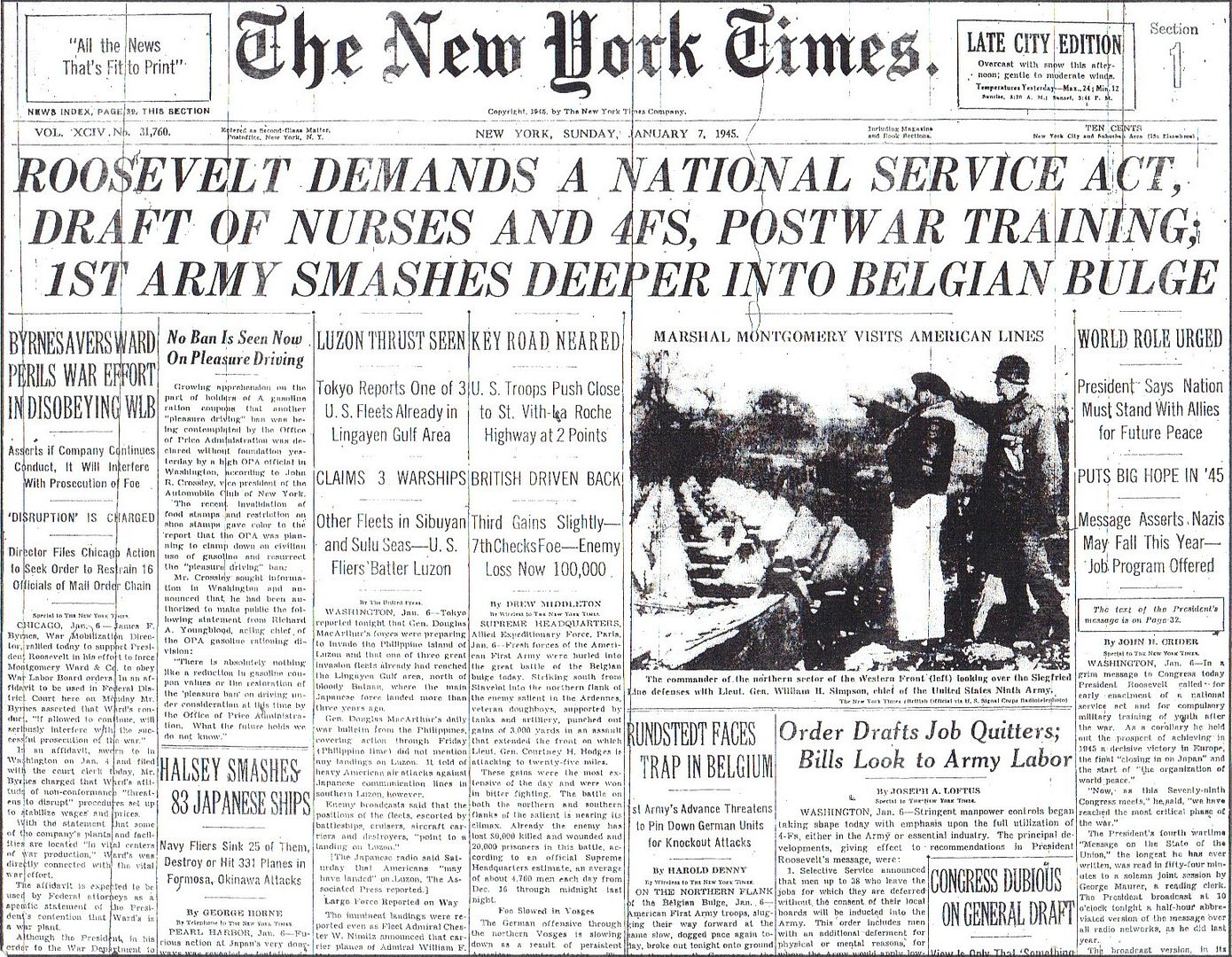
Posted on 01/07/2015 4:15:20 AM PST by Homer_J_Simpson



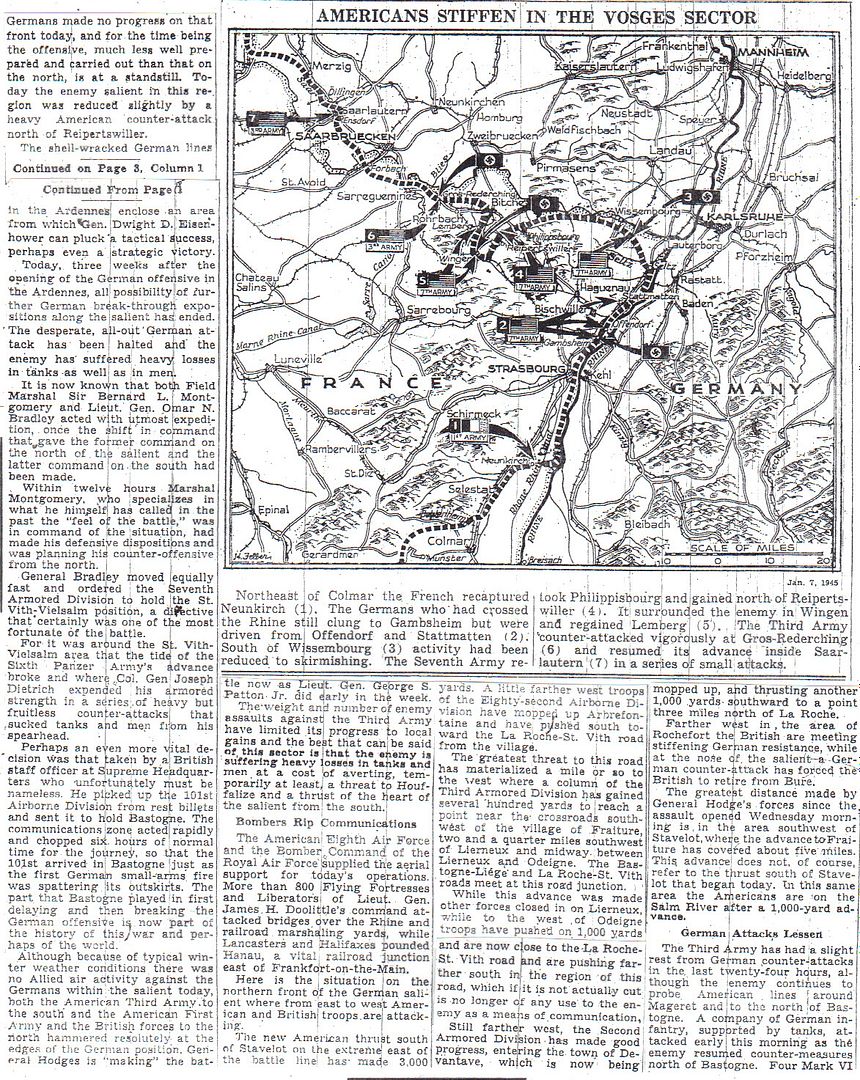


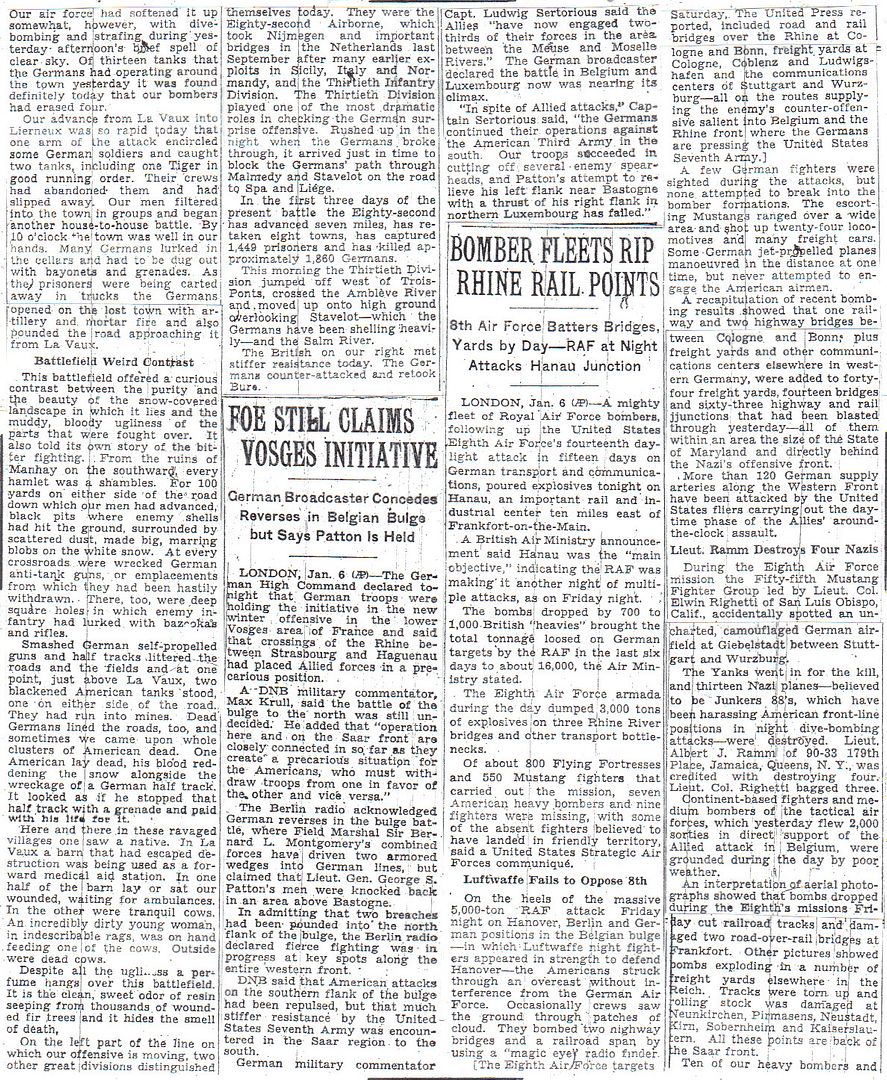
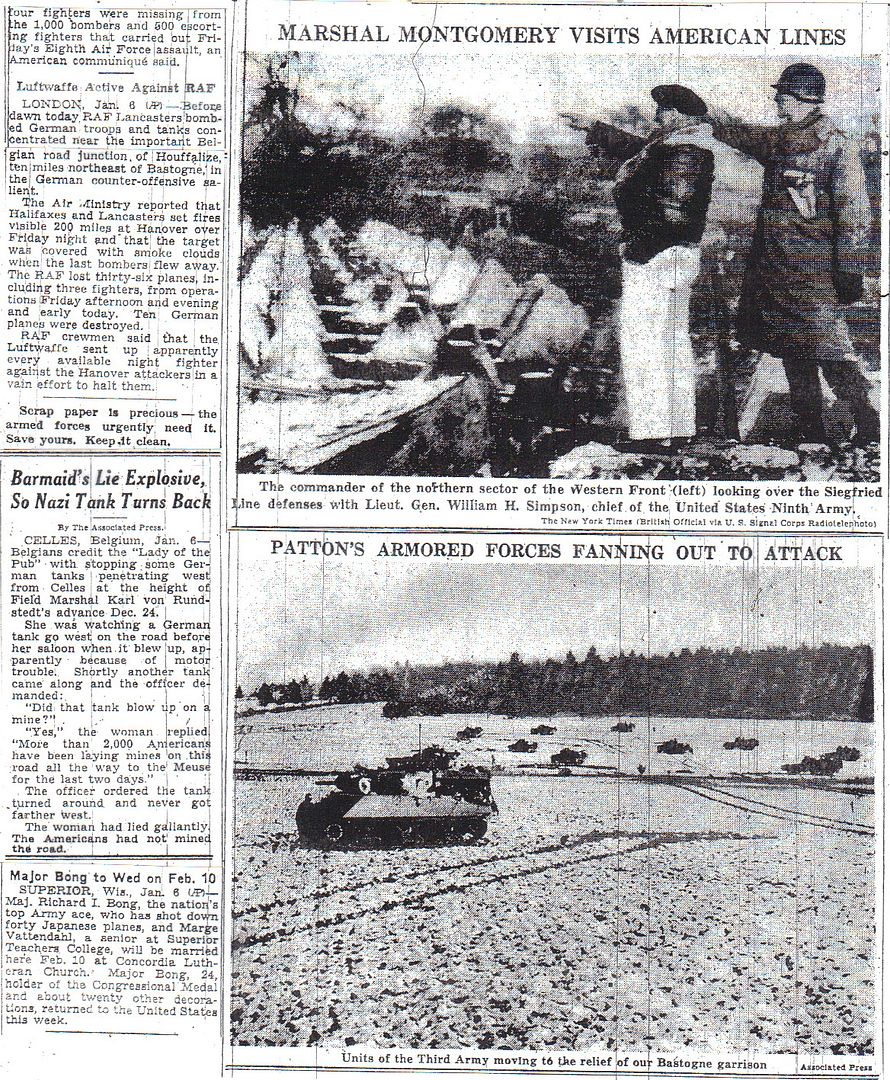
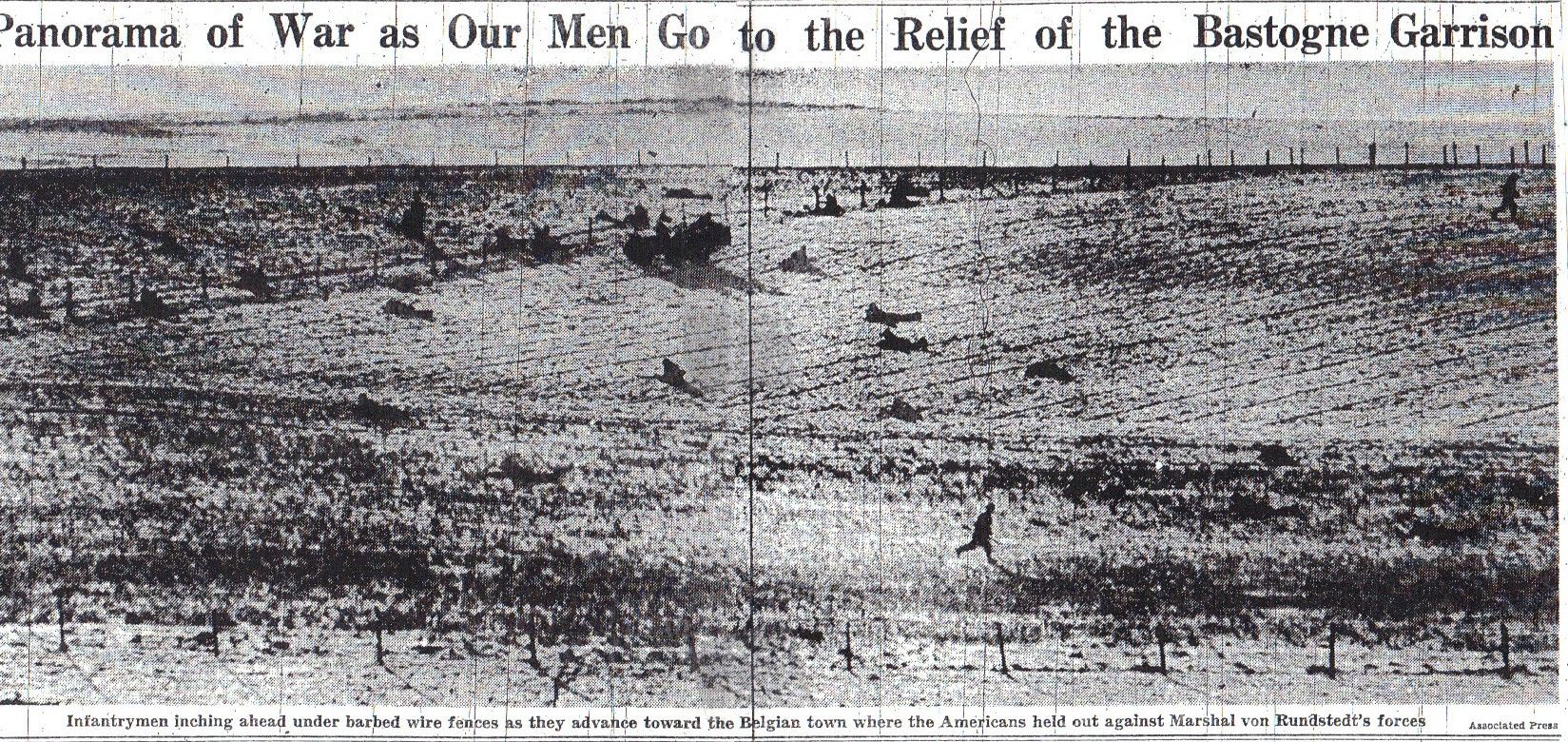
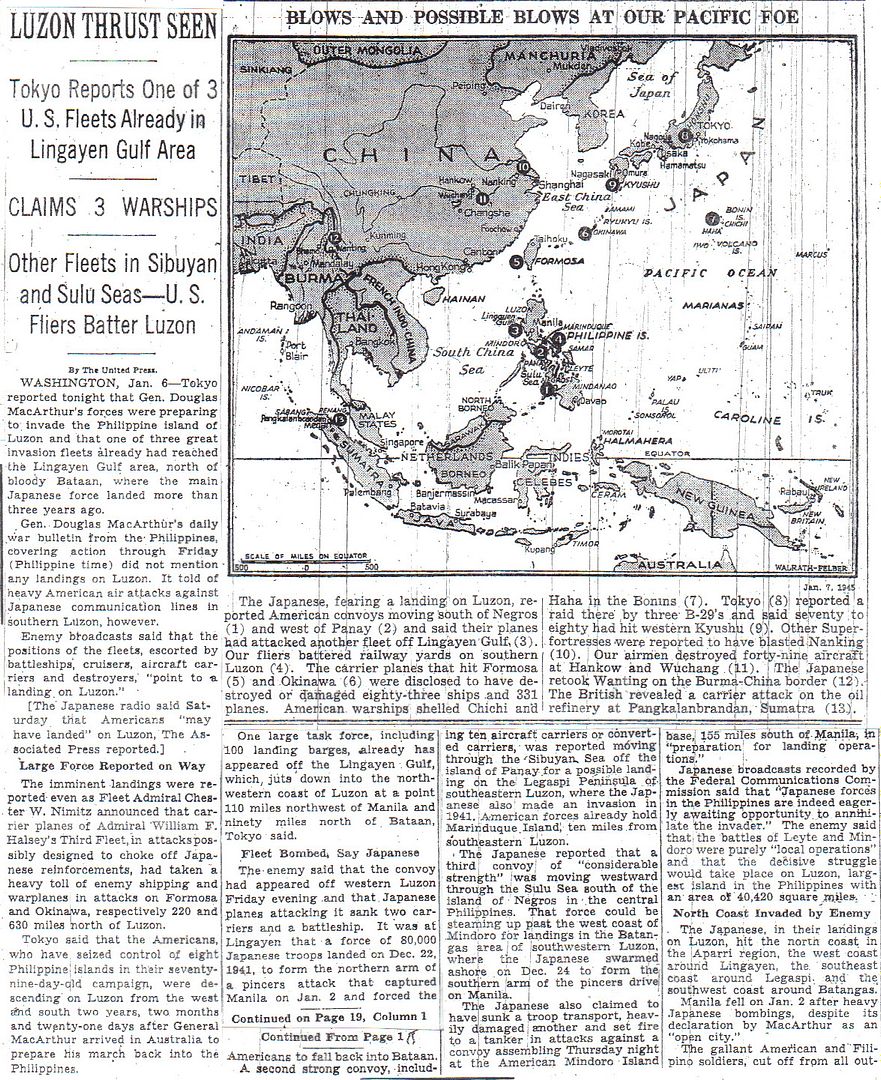

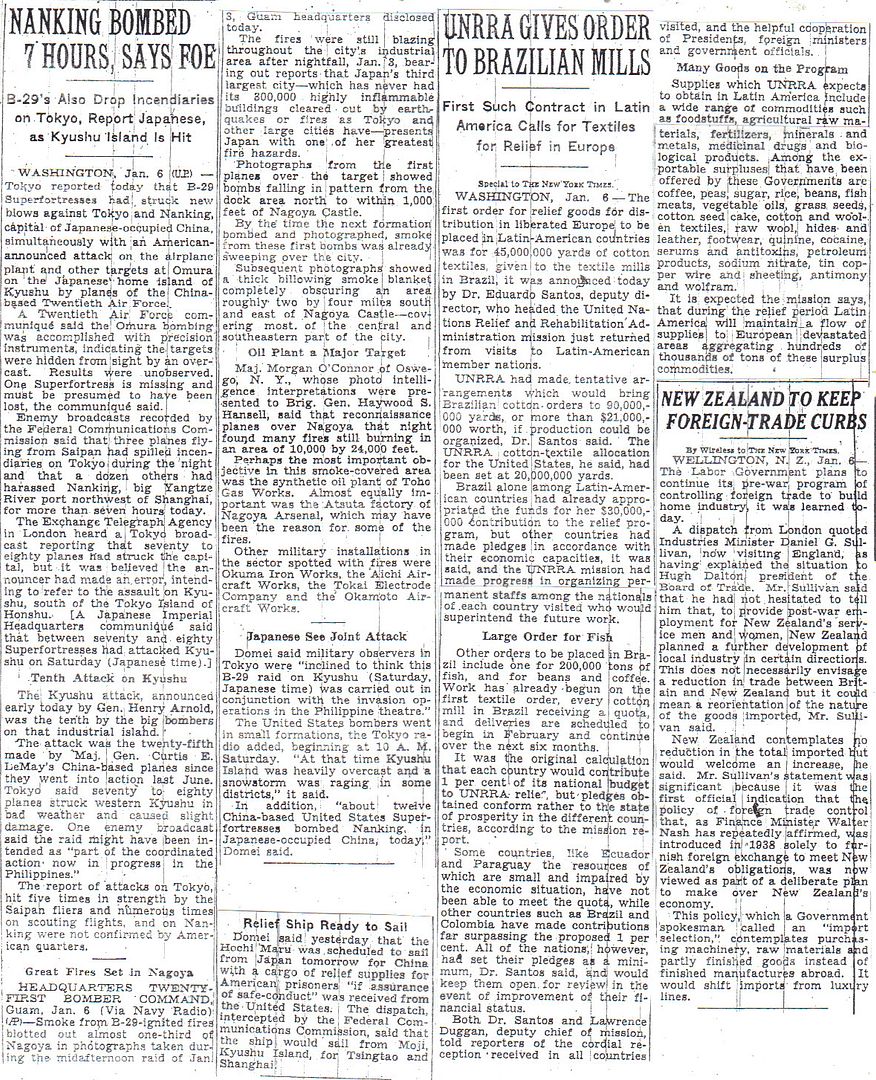
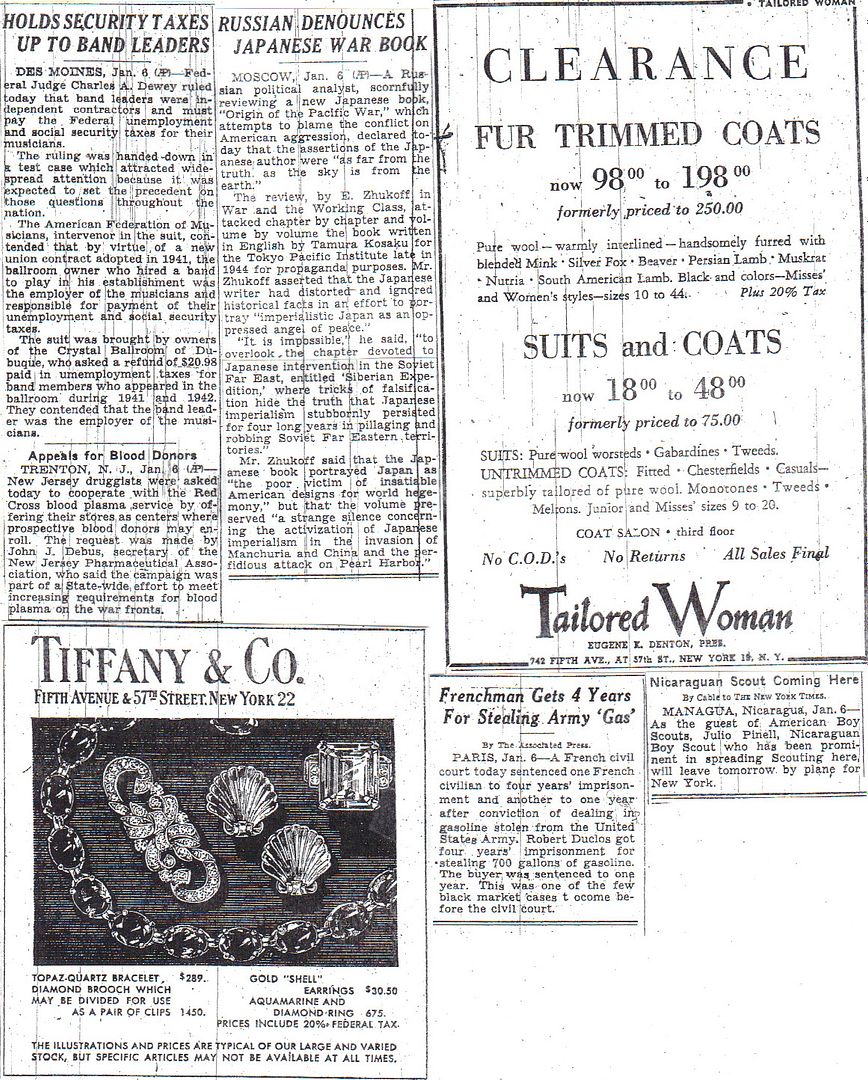
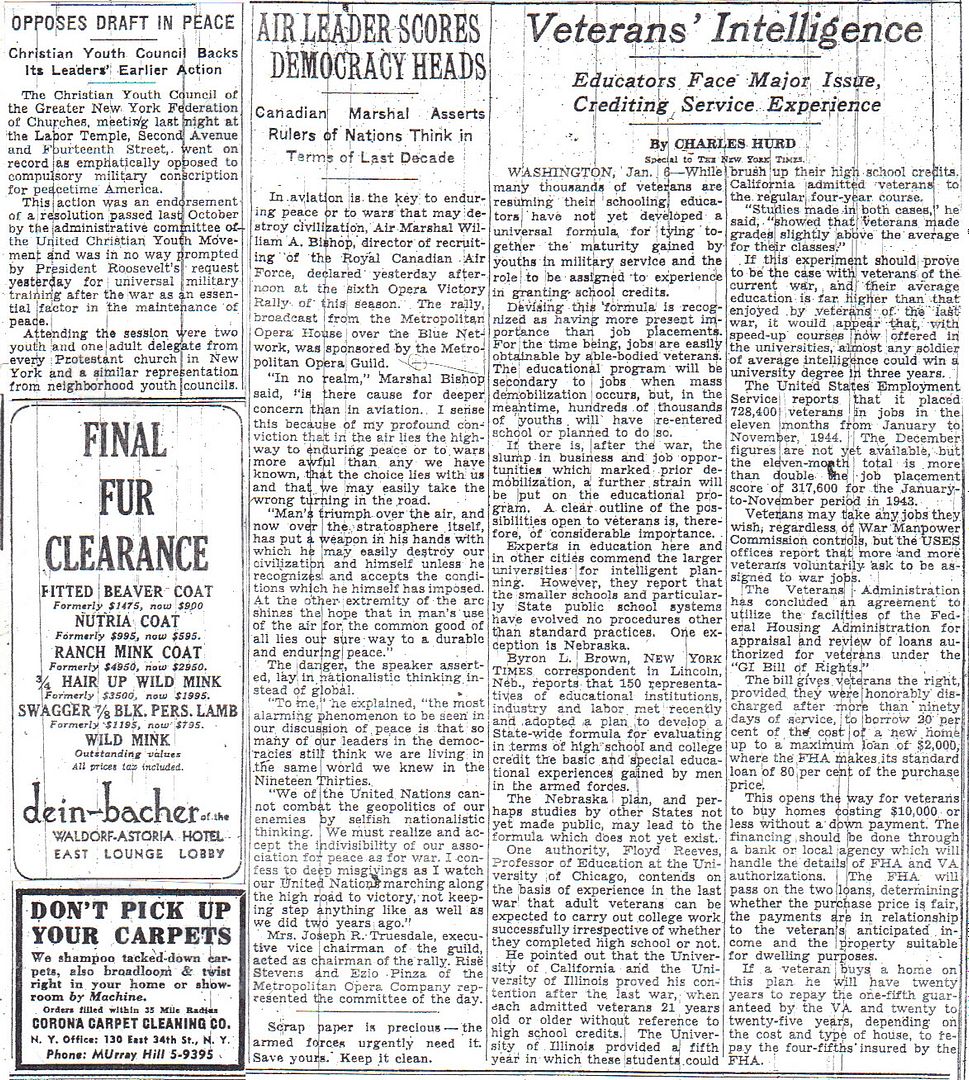
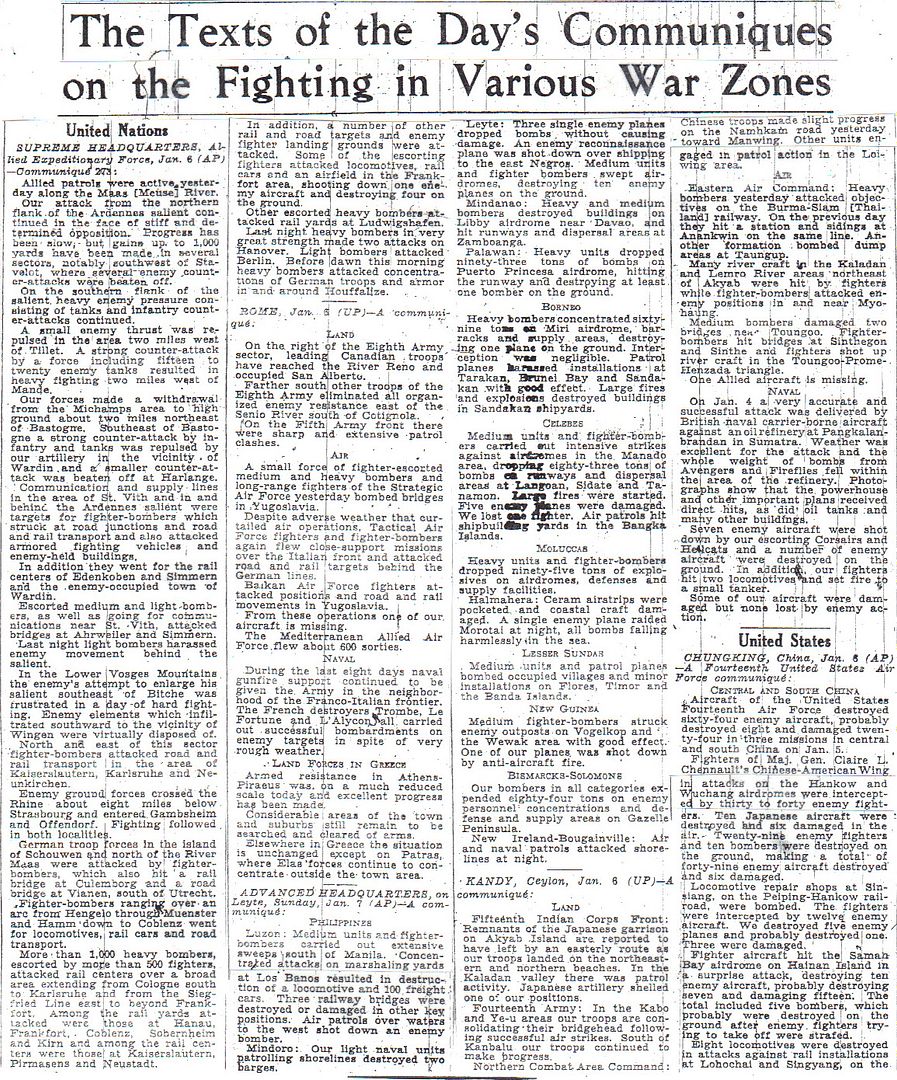

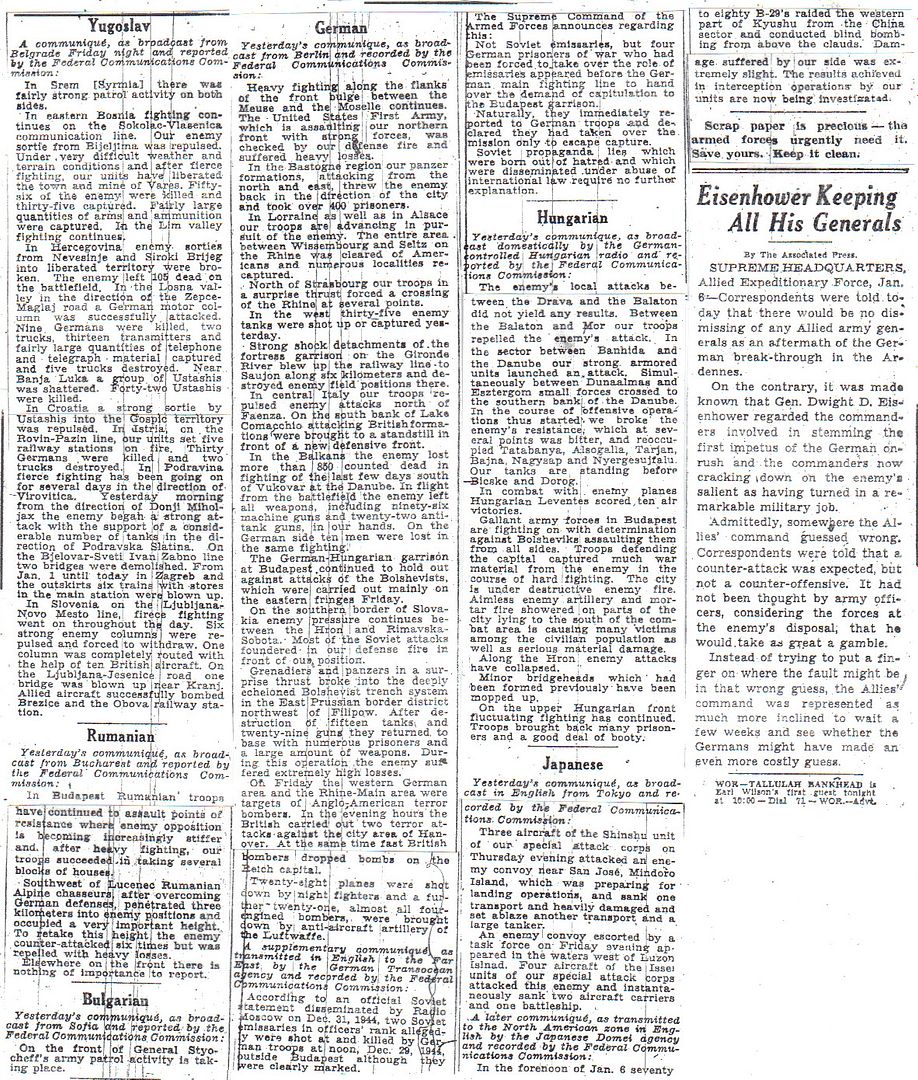
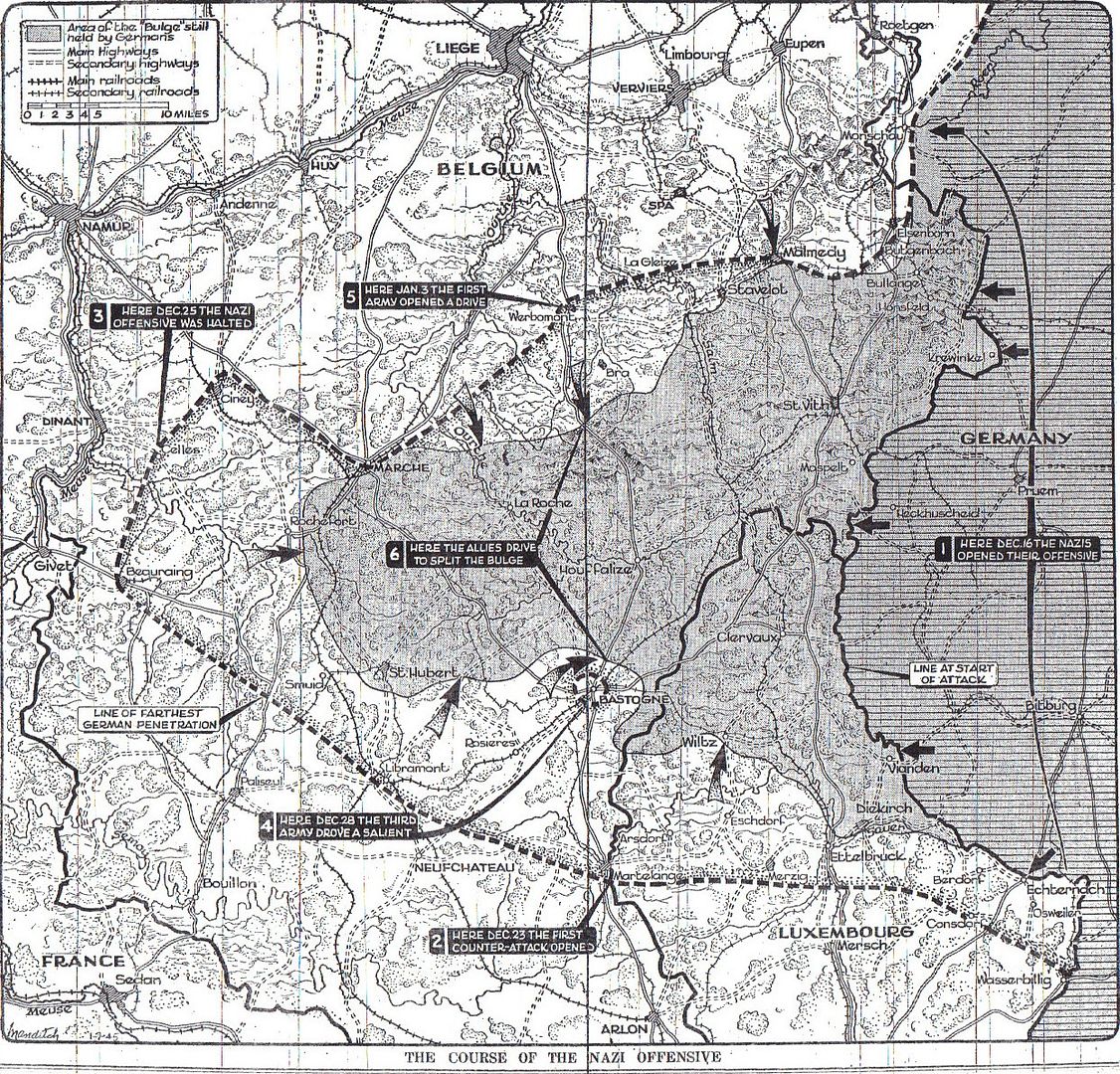
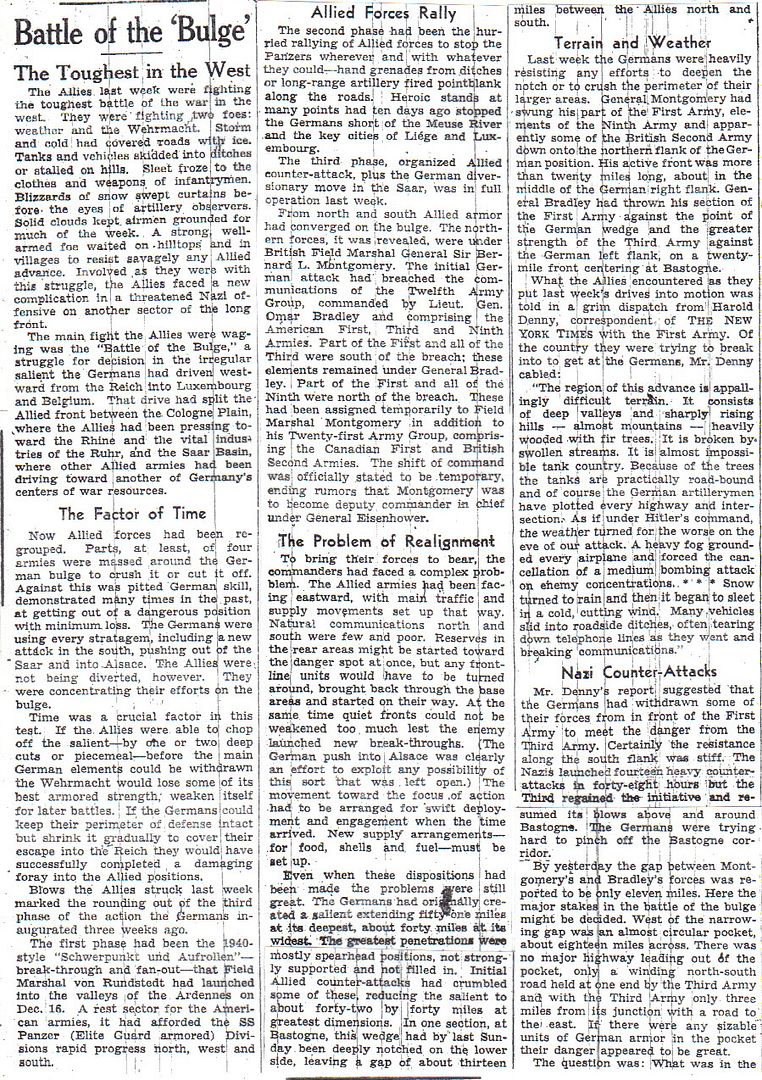
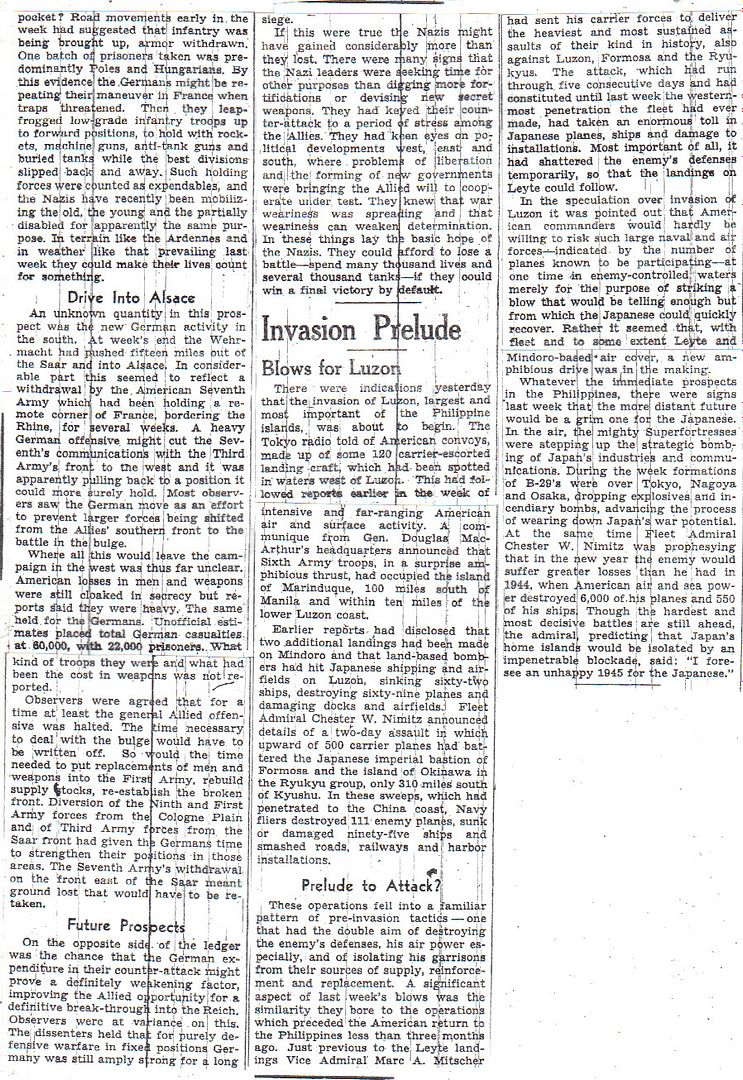
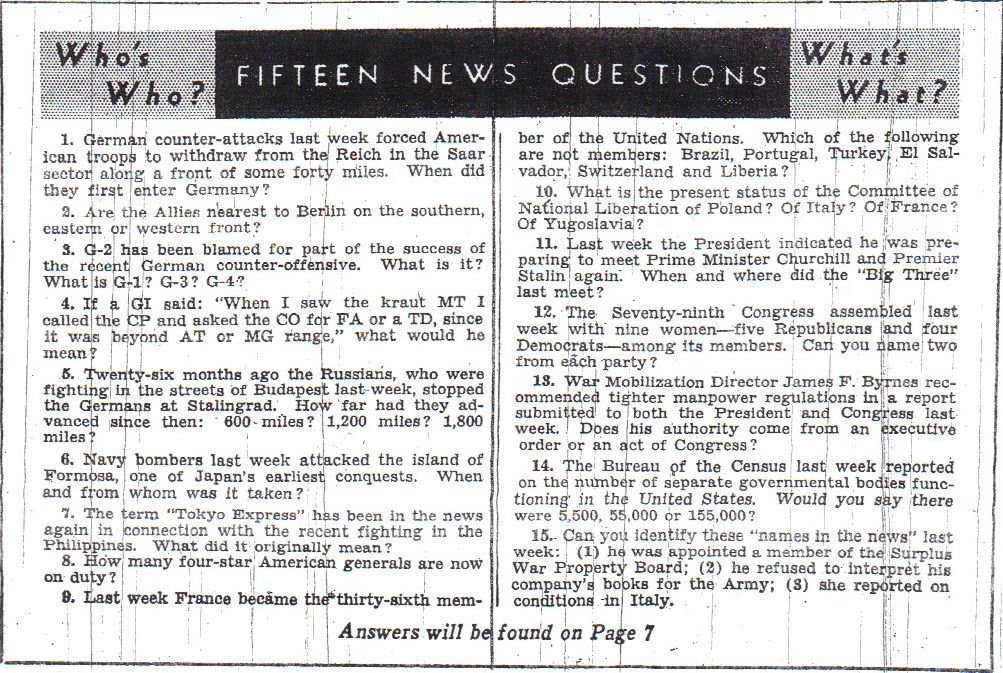
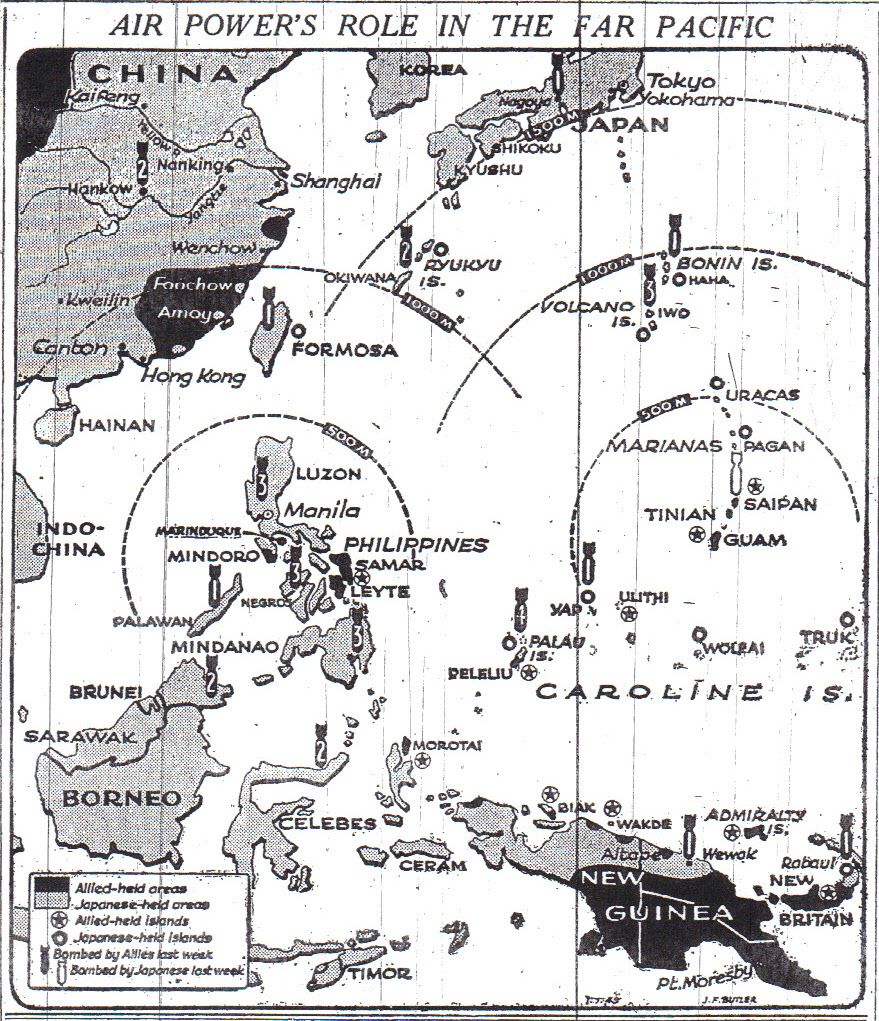
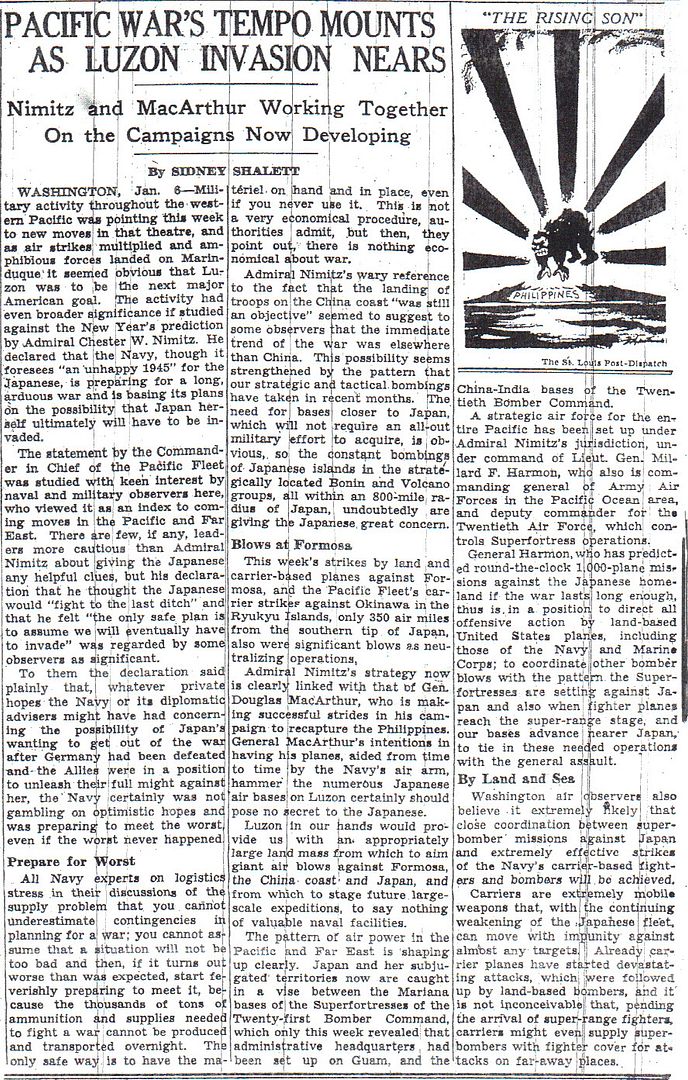

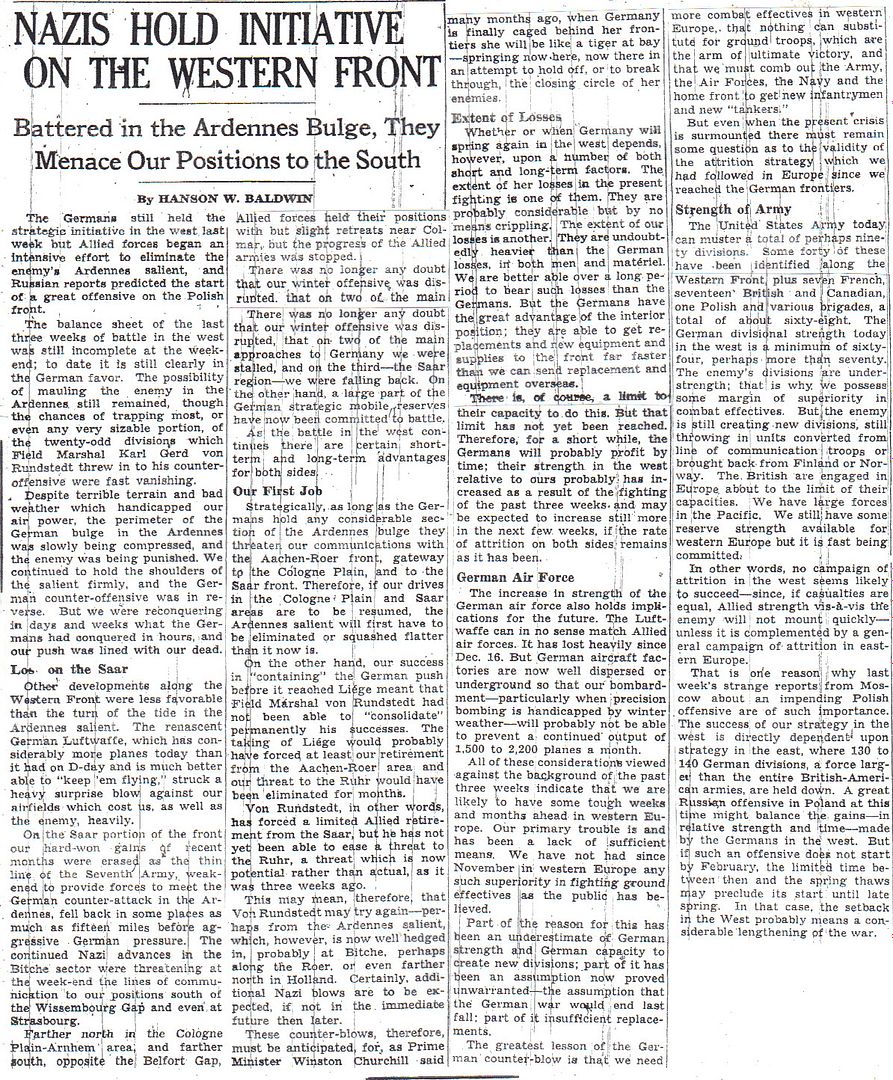
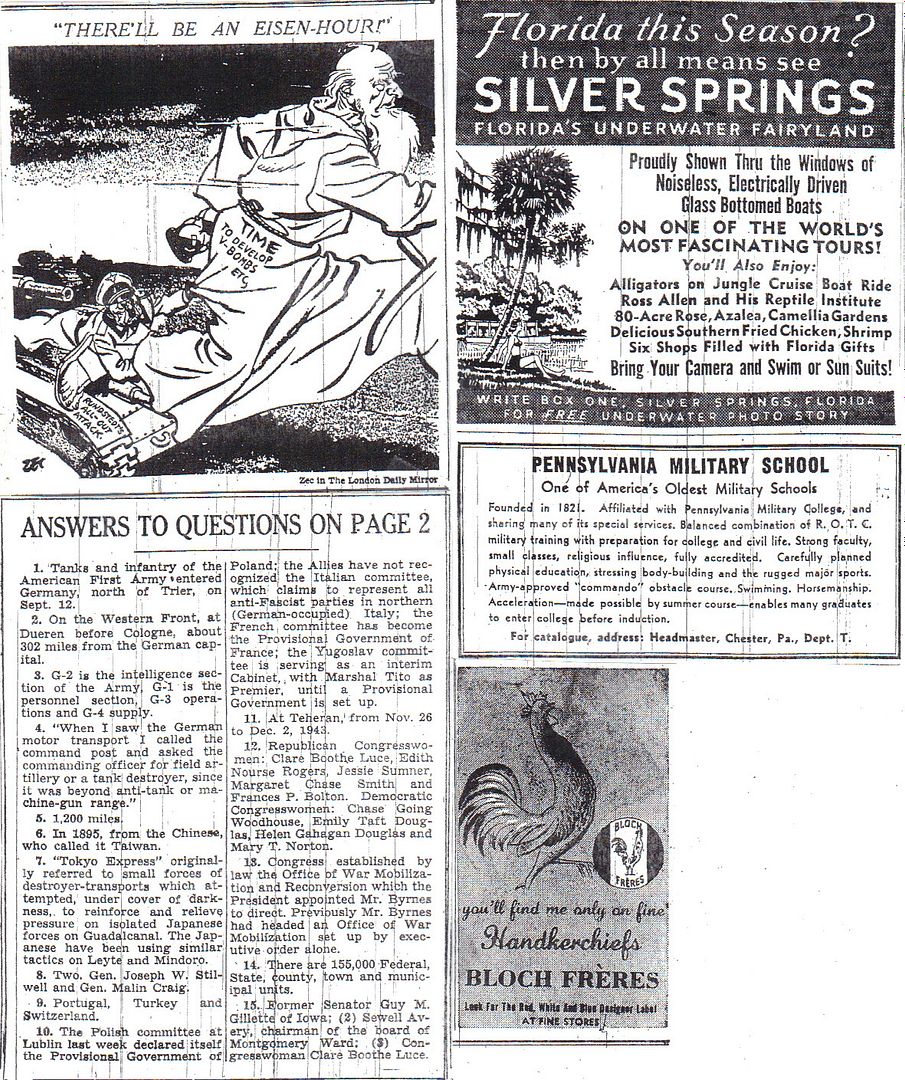

The News of the Week in Review
The Course of the Nazi Offensive (map) – 18
Battle of the ‘Bulge’ – 19-20
Invasion Prelude – 20
Fifteen News Questions – 21
Air Power’s Role in the Far Pacific (map) – 22
Pacific War’s Tempo Mounts as Luzon Invasion Nears (Shalett) – 23
Battle of the West: A Pattern of Attack and Counter-Attack (map) – 24
Nazis Hold Initiative on the Western Front (by Hanson W. Baldwin) – 25
“There’ll Be an Eisen-Hour!” (cartoon) – 26
Answers to Fifteen News Questions – 26
The New York Times Book Review
The Best Selling Books, Here and Elsewhere – 27
My Mother Bids Me Bind My Hair, by Elizabeth Sale (Reviewed by Jane Cobb, first-time contributor) – 27
* Due to the width of the copied photo the scanner cut off about ½” of the left end.
http://www.etherit.co.uk/month/0/07.htm
January 7th, 1945 (SUNDAY)
NORTH SEA: The last RAF Bomber Command Wellington operation is flown on this night by the crew of a No 192 Squadron Wellington Mk. X based at RAF Foulsham, Norfolk, England. The Wellington is on a radar countermeasures flight over the North Sea “to investigate enemy beam signals connected with the launching of flying bombs and believed to emanate from marker buoys.” Bad weather over the North Sea causes the flight to be curtailed but the Wellington lands safely, the last of more than 47,000 sorties carried out by this type of aircraft in Bomber Command.
BELGIUM: British Field Marshal Bernard Montgomery, Commander in Chief 21st Army Group, gives a press conference in which he all but claims complete credit for saving the Allied cause in the Battle of the Bulge. He is almost removed from his command because of the resulting American outcry. Montgomery had already earned the ire of many American officers because of his cautiousness in the field, arrogance off the field, and willingness to disparage his American counterparts. The last straw is Montgomery’s whitewashing of the Battle of the Bulge facts to assembled reporters in his battlefield headquarters-he made his performance in the Ardennes sound not only more heroic but decisive, which necessarily underplayed the Americans’ performance. Since the loss of American life in the battle was tremendous and the surrender of 7,500 members of the 106th Infantry Division humiliating, Lieutenant General Omar Bradley, Commanding General 12th Army Group, complained loudly to General of the Army Dwight D. Eisenhower, Supreme Allied Commander of the Allied Expeditionary Force, who passed the complaints on to British Prime Minister Winston Churchill. On 18 January, Churchill addressed Parliament and announced in no uncertain terms that the “Bulge” was an American battle-and an American victory.
In the British Second Army’s XXX Corps area, the 53d Division takes Grimbiemont.
In U.S. First Army’s VII Corps area, co-ordinated attacks of the 2d Armoured and 84th Infantry Divisions toward Laroche-Salmchteau road, the intermediate objective before Houffalize, make notable progress. Dochamj and Marcouray fall. Only rear guards remain in the Consy area. The 3d Armoured Division seizes Regn, Verleumon Sart, and Grand Sart. In the XVIII Corps (Airborne) area,, the 82d Airborne Division, in a rapid advance of 2-3 miles (3,2 - 4,8 kilometres), clears most of the angle formed by Laroche-Salmchteau road and the Saim River. Some elements secure positions on a ridge just north of Comté; others, during the advance to the Saim River line, clear Goronne, Farniers, Mont, and Rochelinval. Regimental Combat Team 112 seizes Spineux, Wanne, and Wanneranval.
In the U.S. Third Army’s VIII Corps area, the 87th Infantry Division continues its attack on Tillet and is engaged sporadically in the Bonnerue area. The 17th Airborne Division takes Rechrival, Millomont, and Flamierge and reaches the outskirts of Flamizoulle. In the III Corps area, the 6th Armoured Division remains under strong pressure in the Neffe-Wardin region east of Bastogne. The 35th Infantry Division makes a limited attack toward the Lutrebois-Lutremange road, halting just short of it.
FRANCE: The boundary between the U.S. Seventh Army and French First Army is shifted north, giving the French responsibility for the Strasbourg area.
In the U.S. Seventh Army’s VI Corps area, the 45th Infantry Division, on the left flank of the Bitche salient, reaches the heights overlooking Aithorn and overcomes final resistance within Wingen. On the corps eastern flank, the 79th Infantry Division organizes Task Force Wahl (elements of the 313th, 315th, and 222d Infantry Regiments; Combat Command A of the 14th Armoured Division; and the 827th Task Destroyer Battalion) to operate in the northern part of the division front since the German threat to the Maginot Line positions south of Wissembourg is serious. The Germans drive back outposts at Aschbach and Stundweiler. In the Gambsheim bridgehead area, efforts of 317th Infantry Regiment, 79th Infantry Division, to clear Drusenheim are unsuccessful; the French 3d Algerian Division takes over the attack toward Gambsheim from Kilstett.
GERMANY: U-3018 commissioned.
The following U.P. report was released to the newswires - A German communiqué asserted today that U-boats had sunk an 11,000-ton vessel used as a troop transport off Cherbourg, one of the main Allied supply ports in France, and that they had sent nine other vessels, including five warships, to the bottom in attacks on Allied shipping since January 1. There was no Allied confirmation of these claims. The troop transport in question was the SS Leopoldville.
The USAAF Eighth Air Force flies Mission 785: 1,073 bombers and 700 fighters attack communications centres, rail targets, bridges and an oil storage depot in western Germany using PFF methods; three bombers and a fighter are lost. The heaviest raids are the marshalling yard at Hamm bombed by 113 B-17 Flying Fortresses and the communications centre at Bitburg hit by 110 B-17s. Eighteen other targets are hit by 850 bombers.
During the night of 7/8 January, RAF Bomber Command dispatches 645 Lancasters and nine Mosquitos to bomb Munich; 597 bomb the target with the loss of 11 Lancasters and four more crash in France. Bomber Command claims a successful area raid, with the central and some industrial areas being severely damaged. This was the last major raid on Munich. In other attacks, 52 of 54 Mosquitos dispatched bomb Hannover, 18 hit Nuremberg and 12 attack Hanau.
HUNGARY: The Germans continue their efforts to relieve the Budapest garrison, which is being methodically destroyed, and capture Esztergom, northwest of the city. (Jack McKillop
ITALY: In the British Eighth Army area, the Polish II Corps withdraws from the line, turning over its sector and the 5th Kresowa Infantry Division to the British V Corps.
Weather grounds the medium bombers and A-20 Havocs of the USAAF Twelfth Air Force; XXII Tactical Air Command (TAC) fighters and fighter-bombers make six cuts on the Brenner rail line, damage the western end of the rail bridge at Cittadella, and hit the marshalling yard south of Trento; most of the XXII TAC’s effort is concentrated against land and water communications in the La Spezia-Genoa area, including attacks on shipping at Savona and San Remo harbours. XXII TAC A-20 Havocs fly 33 effective sorties in the Po Valley during the night of 7/8 January.
BALTIC SEA: Soviet submarine S-4 is most likely rammed and sunk by the German torpedo boat T 3 or T 33 about 38 nautical miles (71 kilometres) north of Danzig, Poland, in position 54.59N, 18.33E.
CHINA: Five USAAF Fourteenth Air Force B-24 Liberators bomb Ft Bayard and attack shipping in Samah Bay on Hainan Island, sinking a stores ship.
BURMA: Akyab: Allied troops of the 81st and 82nd West African Divisions are advancing down the Burmese coast towards Myebon, buoyed by the capture of Akyab by XV Corps. British Army and Royal Marine commandos had landed there to try to cut off the Japanese retreat, but they were too late; the Japanese forces had been withdrawn towards Mandalay. Now more substantial landings are planned at Myebon and Ramree Island to support the land advance. These land operations have been supported by naval bombardment, notably last month when two Australian destroyers reinforced the light Allied naval force. But many small motor launches are playing an important role here, harrying enemy vessels in the maze of coastal inlets to disrupt supplies, and landing raiding parties.
VOLCANO ISLANDS: Eleven USAAF Seventh Air Force B-24 Liberators, flying out of Saipan, bomb an airfield on Iwo Jima. During the night of 7/8 January ten more B-24s again bomb airfields, striking in single-bomber snooper missions over a 7-hour period.
COMMONWEALTH OF THE PHILIPPINES: Major Thomas B. McGuire was assigned to the 431st Fighter Squadron, 475th Fighter Group based at Dulag, Leyte, Philippine Islands. On that day, McGuire was leading a four-plane flight on a fighter sweep over Negros Island when they were attacked by Japanese aircraft. Normally, the American pilots would release their drop tanks when attacked but McGuire ordered the other three to, “Save your tanks!” This action occurred at low altitude, 200 feet (60.96 meters). One of the Japanese aircraft got on the tail of a P-38 and the pilot called for help while flying in a circle. McGuire responded and his aircraft began to stall out as he tightened his turn until the P-38 went into a full stall. The P-38 snap-rolled and plunged inverted into the ground killing him.
Underwater demolition teams begin a search for underwater obstacles in Lingayen Gulf as preinvasion aerial and naval bombardment of Luzon continues.
Minesweeping destroyer USS Palmer sunk by Japanese aircraft in Lingayen Gulf.
On Mindoro, Japanese planes for the first time are conspicuously absent from the San Jose area.
In major strikes of the day against targets on Luzon Island, large numbers of USAAF Far East Air Forces (FEAF) B-25 Mitchells and A-20 Havocs, supported by P-38 Lightnings, hit the network of airstrips from Clark Field to Angeles Airfield, B-24 Liberators bomb Nielson and Grace Park Airfields and Nichols Field and B-25s and fighter-bombers pound bridges in the Plaridel and Calumpit areas. B-24s raid Padada and Daliao Airfields on Mindanao Island. Other FEAF aircraft on small-scale armed reconnaissance missions strike targets of opportunity throughout the Philippine Islands.
In Lingayen Gulf, Japanese air attacks in the area continue and two USN high speed minesweepers are sunk: USS Hovey (DMS-11) is sunk by an aerial torpedo and USS Palmer (DMS-5) by bombs.
EAST INDIES: In the Netherlands East Indies, USAAF Far East Air Forces B-25 Mitchells and fighter-bombers hit Lembeh Strait and the Langoan areas on Celebes Island while RAAF aircraft fly 661 sorties against Halmahara and Morotai Islands.
PACIFIC OCEAN: The submarine U.S.S. Picuda (SS-382), on her fifth patrol, prowling east of Formosa, fires four torpedoes at A-AO Munakata Maru (10,045T) in a daylight periscope attack in position 25-38N 121-08E. Two torpedoes strike home. Japanese sources claim heavy damage to the tanker.
The post-war Joint Army-Navy Assessment Committee corroborates Japanese sources which claim the vessel was sunk at Keelung on 21 January 1945 by aircraft. However, U.S.S. Barb (SS-220) claims in her patrol report that the ship was seen to blow up at the time of the attack. (Chris Sauder)
In the South China Sea at about 2230 hours, USN destroyers USS Charles Ausburne (DD-570), Braine (DD-630), Russell (DD-414), and Shaw (DD-373) open fire with their guns and sink the Japanese destroyer HIJMS Hinoki, about 86 nautical miles (160 kilometres) west of Manila, Philippine Islands.
CANADA:
Corvette HMCS Thorlock departed Halifax for work ups Bermuda.
Corvette HMCS Trail departed work ups Bermuda for Boston.
U.S.A.: The Swedish ship Gripsholm sails from Jersey City, New Jersey, with approximately 102 persons of German descent and members of their families who had been rounded up in Mexico to use as “exchange material” for Americans caught in Germany. (Mike Yared)
Light cruiser USS Dayton commissioned.
From Atkinson’s The Guns at Last Light
This spans a few days, but it is so short that to post individual days would lose the meaning.
SAHEF on January 5 confirmed an American press report that the U.S. First and Ninth Armies now fought under British command. The statement from Versailles claimed that the arrangement had been made “by instant agreement of all concerned,“ but failed to explain that the reconfiguration was only temporary. Smug accounts in London newspapers began describing GIs as ‘Monty’s troops”; privately encouraged by the field marshal, the press clamored for a “proper” chain of command in the northwestern Europe, under a single battle captain.
“We have nothing to apologize for,” Bradley told his staff. “We have nothing to explain.” Major Hansen wrote in his diary, “Many of us who were avowed Anglophiles in Great Britain have now been irritated, hurt, and infuriated by the British radio and press. All this good feeling has vanished.”
On Saturday, January 6, Montgomery cabled Churchill that he planned to summon reporters to explain “how [the] Germans were first ‘headed off,’ then ‘seen off,’ and now are being ‘written off.’” He also intended to rebut any suggestion of American failure in the Ardennes. “I shall show how the whole Allied team rallied to the call and how national considerations were thrown overboard…. I shall stress the great friendship between myself and Ike.”
On the same day, he wrote a confidant in London, “The real trouble with the Yanks is that they are completely ignorant as to the rules of the game we are playing with the Germans.” When Brigadier Williams, the intelligence chief, asked why he intended to hold a press conference, Montgomery explained that Eisenhower’s generalship had been impugned and “I want to put it right.” Williams offered two words of counsel: “please don’t.” Other in his headquarters, smelling condescension, also sought to dissuade him. Alan Moorehead pleaded with De Guingand to muzzle Montgomery, lest he “make some bloody awful mistake.”
“That’s a funny position for a newsman to take,” De Guingand said.
“I want to win the war,” Moorehead replied.
In a double-badged maroon beret and a parachute harness – “dressed like a clown,” in Moorehead’s description – the field marshal appeared before a gaggle of correspondents in Zonhoven on January 7. No doubt he meant well. Praising the GI as a “brave fighting man, steady under fire, and with that tenacity in battle which stamps the first-class soldier,” he also saluted Eisenhower as ‘the captain of our team,” declaring, “I am absolutely devoted to Ike. We are the greatest of friends.” No mention was made of Bradley, and an assertion the British troops were “fighting hard” exaggerated their role as reserves very much on the fringe of the battlefield.
Much of the recitation, however, was devoted to describing the field marshal’s own brilliance upon taking command almost three weeks earlier. “The first thing I did,” Montgomery said, “was busy myself in getting the battle area tidy-getting it sorted out”:
As soon as I saw what was happening I took certain steps myself to ensure that if the Germans got to the Meuse they would certainly not get over that river. And I carried out certain movements so as to provide balanced dispositions…. I was thinking ahead…. The battle has been most interesting. I think possibly one of the most interesting and tricky battles I have ever handled.
Montgomery likened “seeing off” the enemy to his repulse of Rommel in Egypt in 1942. He closed by declaring, without a scintilla of irony, “Let us have done with the destructive criticism that aims blows at Allied solidarity.”
“Oh, God, why didn’t you stop him?” Morrehead asked Williams as reporters scattered to file their stories. “It was so awful.” Many British officers agreed. The field marshal had been “indecently exulted,” as one put it, displaying “what a good boy am I” self-regard, in De Guingand’s phrase, and conveying what another general called his “cock on a dunghill mood.” A headline in the Daily Mail – “Montgomery Foresaw Attack, Acted ‘On Own’ to Save Day” – captured the prevailing Fleet Street sentiment, although Churchill’s private secretary told his diary, “Monty’s triumphant, jingoistic, and exceedingly self-satisfied talk to the press on Sunday has given wide offense,” A mischievous German radio broadcast mimicked the BBC with a phony news flash that quoted Montgomery as describing the Americans as “’somewhat bewildered.’ … The battle of the Ardennes can now be written off, thanks to Field Marshal Montgomery.”
“He sees fit to assume all the glory and scarcely permits the mention of an army commander’s name,” the Ninth Army war diary complained. “Bitterness and real resentment is [sic] creeping in.” No one was more bitter or resentful than Bradley, whose “contempt had grown into active hatred” for Montgomery, reported on British general at SHAEF. Air Marshal Tedder informed his diary that cooperation between Bradley and the field marshal was now “out of the question.”
Bradley called twice Versailles on Tuesday January 9, “very much upset over the big play Monty is getting in the British press,” Kay Summersby noted. He, too, summoned reporters, using a map and a pointer to render his own version of events, which included the dubious assertion that American commanders had consciously taken “a calculated risk” in thinning out defenses in the Ardennes. Privately he denounced Montgomery’s “attempt to discredit me so he could get control of the whole operation.” The field marshal, he asserted wanted to “be in on the kill, and no one else.”
In another call to Eisenhower, Bradley warned, I cannot serve under Montgomery. If he is to be put in command of all ground forces, you must send me home.”
Eisenhower assured him that he had no plans to expand the field marshal’s authority, then added, “I thought you were the one person I could count one for doing anything I asked you to do.”
“This is one thing I cannot take,” Bradley replied.
Once again Eisenhower sought to mollify, to mediate, and to keep his temperamental subordinates concentrated on the task at hand: evicting Rundstedt from the Bulge and resuming the march on Germany. But in a note to Brooke he admitted, “No single incident that I have encountered throughout my experience as an Allied commander has been so difficult.”
National Service Draft sounds like something Obama would want.
Draft of nurses sounds like something Joe Biden would want.
Biden is the leader of the Daft Clown Posse
Thanks for a great post.
My own view is not so much to blame Montgomery for being, well, Montgomery.
As Rush might say: a lion is a lion, regardless.
But as lion-tamer-in-chief, I think Ike earned his pay, and then some.
It suggests he might be, uh, qualified, for higher responsibilities, say, after the war... oh, I don't know, maybe a University president?
;-)
It’s interesting what you see in these papers. Bottom of page 13, the Tiffany and Company ad “Prices include 20% federal tax.” Even during a depression and war, the fed still takes its bite.
It reminds us:
Sometimes, almost a cartoon character if there wasn't so much at stake.
Once again Eisenhower sought to mollify, to mediate, and to keep his temperamental subordinates concentrated on the task at hand: evicting Rundstedt from the Bulge and resuming the march on Germany. But in a note to Brooke he admitted, “No single incident that I have encountered throughout my experience as an Allied commander has been so difficult.”
Again, with Monty's antics especially, Hitler almost hit the nail on the head in hoping the counter-offensive would create an Allied split.
At the time of his death, General Rose was the highest ranking Jewish-American officer of WWII. He was the son and grandson of Polish rabbis.
A group of leaders in the Colorado Jewish community will launch a nationwide fundraising effort to raise the money to build the Rose Medical Center, a place where people would be treated and staff hired without regard to race, religion or national origin. The cornerstone will be laid by Gen. Eisenhower in 1948.
Rose remains an outstanding hospital and is my family's hospital of choice when a need arises.

Very interesting story. I’ve fallen behind a little on the war news; stuff happening out here in 2015.
Interesting book-notes on the last page. I liked the review of the novel!
So, I guess you could say that in a sense, Hitler’s Ardennes offensive was aimed primarily at Montgomery’s ego.
A nice little bit of writing, now that you mention it. It is sort of an accidental part of the post. I like to get the best-sellers list in at least once a month and the review was part of the same print-out.
Disclaimer: Opinions posted on Free Republic are those of the individual posters and do not necessarily represent the opinion of Free Republic or its management. All materials posted herein are protected by copyright law and the exemption for fair use of copyrighted works.